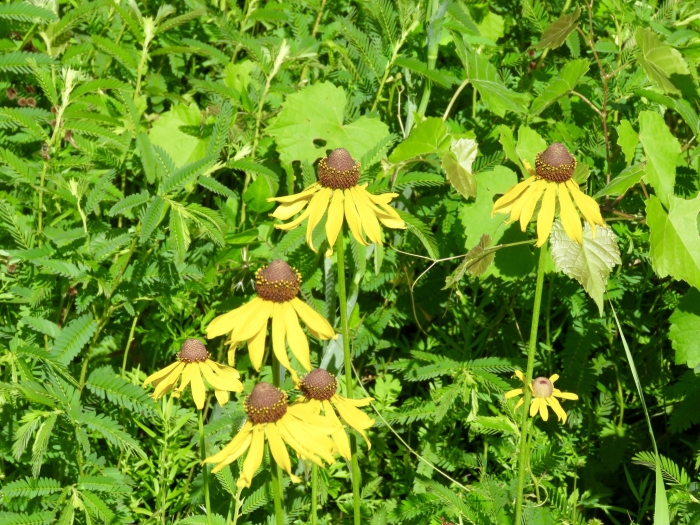Rough Coneflower
(Rudbeckia grandiflora)
Rough Coneflower (Rudbeckia grandiflora)
/
/

Laura Clark
CC BY 4.0
Image By:
Laura Clark
Recorded By:
Copyright:
CC BY 4.0
Copyright Notice:
Photo by: Laura Clark | License Type: CC BY 4.0 | License URL: http://creativecommons.org/licenses/by/4.0/ | Rights Holder: Laura Clark | Publisher: iNaturalist | Date Created: 2016-06-20T10:30:40-07:00 |




















Estimated Native Range
Summary
Rudbeckia grandiflora, commonly known as Rough Coneflower, is a deciduous perennial herb native to the tallgrass prairies and open woodlands of the Central United States. It typically grows to a height of 3-4 feet (0.9-1.2 meters) and a width of 2-3 feet (0.6-0.9 meters). The plant features a clumping form with stiff, hairy stems and rough-textured, lance-shaped leaves. From midsummer to early fall, it produces showy daisy-like flowers with bright yellow rays surrounding a prominent, raised central cone that is dark brown to purple in color.
Rough Coneflower is valued for its long blooming period and its ability to attract pollinators such as butterflies and bees. It is often used in wildflower gardens, naturalized areas, and as a border plant. This species is drought-tolerant once established and thrives in full sun, though it can tolerate light shade. It prefers well-drained soils but is adaptable to various soil types. While generally low-maintenance, Rudbeckia grandiflora can be susceptible to powdery mildew and other fungal diseases in humid conditions. Deadheading spent flowers can encourage additional blooming and prevent excessive self-seeding.CC BY-SA 4.0
Rough Coneflower is valued for its long blooming period and its ability to attract pollinators such as butterflies and bees. It is often used in wildflower gardens, naturalized areas, and as a border plant. This species is drought-tolerant once established and thrives in full sun, though it can tolerate light shade. It prefers well-drained soils but is adaptable to various soil types. While generally low-maintenance, Rudbeckia grandiflora can be susceptible to powdery mildew and other fungal diseases in humid conditions. Deadheading spent flowers can encourage additional blooming and prevent excessive self-seeding.CC BY-SA 4.0
Plant Description
- Plant Type: Subshrub, Herb
- Height: 3-4 feet
- Width: 2-2.5 feet
- Growth Rate: Moderate
- Flower Color: Yellow, Brown
- Flowering Season: Summer, Fall
- Leaf Retention: Deciduous
Growth Requirements
- Sun: Full Sun
- Water: Medium
- Drainage: Medium
Common Uses
Bee Garden, Bird Garden, Butterfly Garden, Deer Resistant, Drought Tolerant, Hummingbird Garden, Low Maintenance, Rabbit Resistant, Showy Flowers
Natural Habitat
Native to tallgrass prairies and open woodlands
Other Names
Common Names: Large-Flowered Coneflower, Rudbeckie Grandiflore, Rudbeckie À Grandes Fleurs
Scientific Names: , Rudbeckia grandiflora, Centrocarpha grandiflora, Rudbeckia nudicaulis,
GBIF Accepted Name: Rudbeckia grandiflora (Sw.) J.F.Gmel. ex DC.